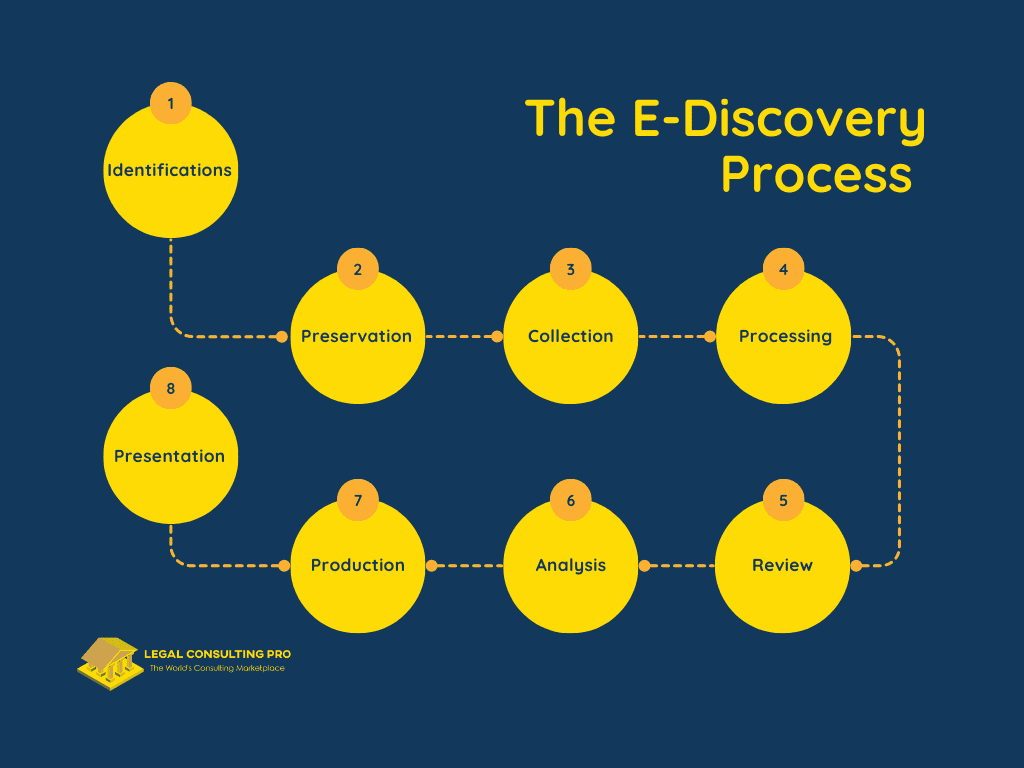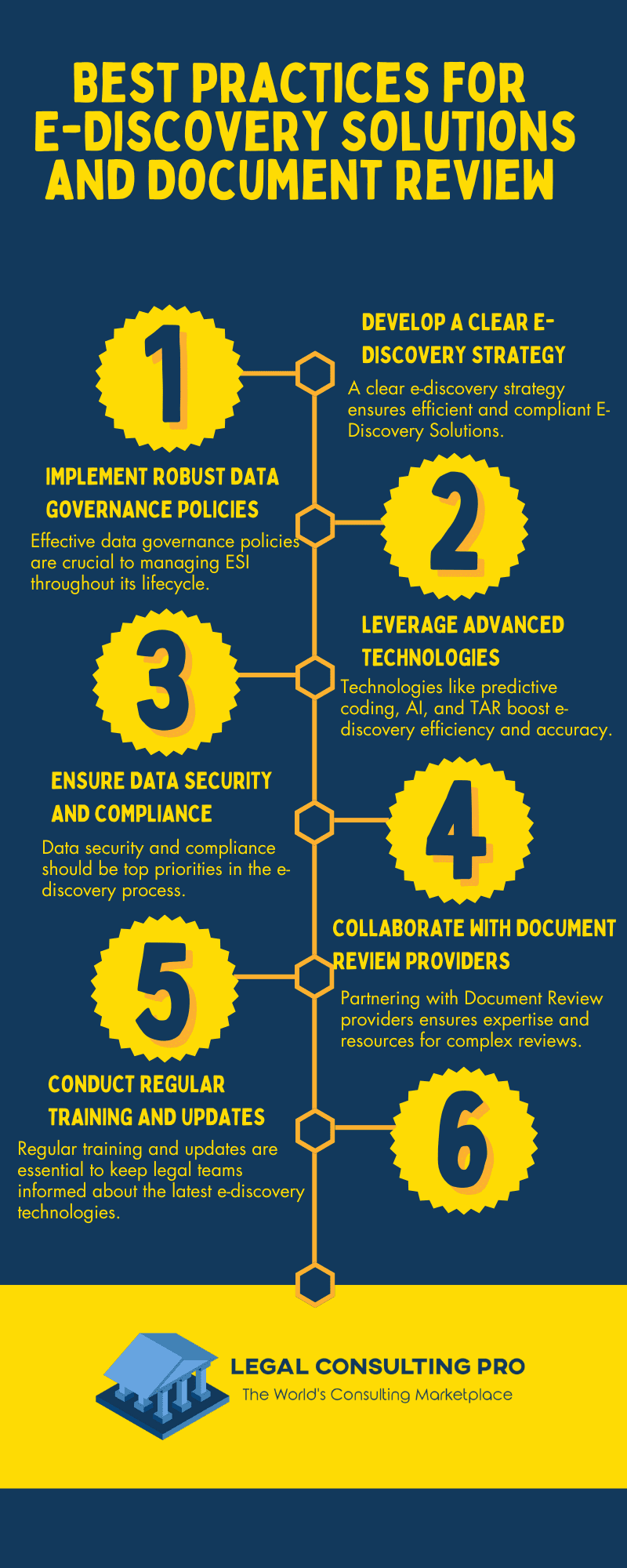Electronic discovery, commonly known as e-discovery, has become an essential component of modern litigation and regulatory investigations. As the volume of electronically stored information (ESI) continues to grow exponentially, the need for effective e-discovery solutions has become more critical than ever. This comprehensive guide delves into the fundamentals of e-discovery, explores various e-discovery solutions, and highlights the importance of managed document review in the e-discovery process.
Understanding E-Discovery
E-discovery refers to the process of identifying, collecting, preserving, reviewing, and producing electronically stored information (ESI) in response to legal requests. This information can include emails, documents, databases, social media posts, and other digital content that may be relevant to a legal case. The e-discovery process involves several stages, each requiring meticulous attention to detail and a thorough understanding of legal and technological principles.
The E-Discovery Process
- Identification: The first step in e-discovery is identifying potential sources of ESI that may be relevant to the case. This involves determining the types of data that may be needed and where they are stored, such as emails, databases, cloud storage, and mobile devices.
- Preservation: Once potential sources of ESI are identified, it is crucial to preserve the data to prevent alteration or deletion. Preservation involves placing legal holds on relevant data sources and ensuring that data integrity is maintained.
- Collection: The next step is collecting the preserved data. This involves extracting relevant information from various sources and creating a defensible data collection process to ensure that the data is admissible in court.
- Processing: During the processing stage, collected data is organized, indexed, and converted into a format suitable for review. This step often involves removing duplicates and irrelevant information to streamline the review process.
- Review: The review stage is one of the most time-consuming and critical parts of e-discovery. During this phase, legal teams review the processed data to identify relevant information, privileged communications, and confidential material.
- Analysis: Analysis involves examining the reviewed data to uncover patterns, trends, and key facts relevant to the case. This step can provide valuable insights and help build a stronger legal strategy.
- Production: In the production stage, relevant and non-privileged data is compiled and delivered to the requesting party in a format agreed upon by both parties.
- Presentation: Finally, the relevant data is presented in court or during negotiations. This stage may involve creating visual aids, timelines, and other tools to effectively communicate the findings.

E-Discovery Solutions
As the complexity and volume of ESI increase, legal professionals rely on a range of e-discovery solutions to manage the process efficiently. These solutions leverage advanced technologies, such as artificial intelligence (AI) and machine learning, to streamline various stages of e-discovery.
E-Discovery Software
E-discovery software platforms are designed to automate and simplify the e-discovery process. These platforms offer a range of features, including:
- Data Collection: Automated tools for collecting data from various sources, ensuring that no relevant information is overlooked.
- Data Processing: Advanced algorithms for processing and organizing large volumes of data, reducing the time and effort required for manual processing.
- Review and Analysis: AI-powered tools for reviewing and analyzing data, identifying relevant information, and flagging potential issues.
- Production: Tools for compiling and producing data in a format that complies with legal requirements.
Popular e-discovery software platforms include Relativity, Exterro, Nuix, and Logikcull.
Managed Document Review
Document Review is a critical component of the e-discovery process, involving the review and analysis of large volumes of documents to identify relevant information. Managed document review services offer several advantages:
- Expertise: Document Review providers have specialized teams with expertise in e-discovery and legal review. These professionals are trained to identify relevant information, privileged communications, and confidential material.
- Efficiency: Managed document review services leverage advanced technologies, such as predictive coding and AI, to expedite the review process and improve accuracy.
- Scalability: Document Review providers can quickly scale their resources to handle large volumes of data, ensuring that deadlines are met.
- Cost-Effectiveness: By outsourcing document review tasks to specialized providers, legal teams can reduce labor costs and focus on core legal strategies.
Predictive Coding and AI
Predictive coding and AI are revolutionizing the E-Discovery Solutions process by enhancing the efficiency and accuracy of document review. Predictive coding involves training a machine learning model to identify relevant documents based on initial coding by human reviewers. AI technologies, such as natural language processing (NLP), can analyze the context of documents to identify key information and patterns.
These technologies offer several benefits:
- Speed: Predictive coding and AI can quickly categorize large volumes of documents, reducing the time required for manual review.
- Accuracy: Advanced algorithms can detect patterns and nuances that may be missed by human reviewers, improving the accuracy of the review process.
- Consistency: Once trained, AI models apply the same criteria consistently across all documents, ensuring uniformity in the review process.
Data Security and Compliance
Data security and compliance are paramount in the e-discovery process. E-discovery solutions must adhere to stringent data protection regulations, such as the General Data Protection Regulation (GDPR) and the California Consumer Privacy Act (CCPA). Key considerations include:
- Data Encryption: Encrypting data at rest and in transit to protect sensitive information from unauthorized access.
- Access Controls: Implementing robust access controls to ensure that only authorized personnel can access sensitive data.
- Audit Trails: Maintaining detailed audit trails to track all actions taken during the e-discovery process, ensuring accountability and transparency.
- Compliance with Legal Requirements: Ensuring that E-Discovery solutions comply with relevant legal and regulatory requirements to avoid penalties and legal issues.
The Role of Managed Document Review in E-Discovery
Document Review is a vital aspect of the E-Discovery Solutions process, providing the expertise and resources needed to handle complex document review tasks. The role of managed document review in e-discovery can be broken down into several key areas:
Expert Review Teams
Document Review providers employ specialized teams of legal professionals with expertise in E-Discovery Solutions and document review. These teams are trained to identify relevant information, privileged communications, and confidential material, ensuring that no critical information is overlooked.
Technology-Assisted Review (TAR)
Technology-assisted review (TAR) leverages machine learning and AI to expedite the document review process. TAR involves training a machine learning model to identify relevant documents based on initial coding by human reviewers. This technology can significantly reduce the time and effort required for manual review, allowing legal teams to focus on more complex tasks.
Quality Control
Quality control is essential to ensure the accuracy and completeness of the document review process. Document Review providers implement rigorous quality control measures, such as double-checking reviewed documents and conducting random audits, to identify and correct any errors.
Scalability and Flexibility
Managed document review providers offer scalability and flexibility, allowing legal teams to quickly adjust resources based on the volume of documents. This is particularly important in large-scale litigation and regulatory investigations, where the volume of ESI can be overwhelming.
Cost-Effectiveness
Outsourcing document review tasks to Document Review providers can be cost-effective, reducing labor costs and allowing legal teams to focus on core legal strategies. By leveraging advanced technologies and specialized expertise, managed document review providers can streamline the review process and improve efficiency.
Best Practices for E-Discovery Solutions and Document Review
To maximize the effectiveness of e-discovery solutions and Document Review, legal teams should follow several best practices:
Develop a Clear E-Discovery Strategy
A well-defined e-discovery strategy is essential to ensure that the E-Discovery Solutions process is efficient and compliant. This strategy should outline the steps for identifying, preserving, collecting, processing, reviewing, and producing ESI, as well as the roles and responsibilities of each team member.
Implement Robust Data Governance Policies
Effective data governance policies are crucial to managing ESI throughout its lifecycle. These policies should address data classification, retention, and disposal, as well as access controls and data security measures.
Leverage Advanced Technologies
Advanced technologies, such as predictive coding, AI, and TAR, can significantly enhance the efficiency and accuracy of the e-discovery process. Legal teams should leverage these technologies to streamline document review tasks and improve the overall quality of the review process.
Ensure Data Security and Compliance
Data security and compliance should be top priorities in the e-discovery process. Legal teams should implement robust data protection measures, such as encryption, access controls, and audit trails, to safeguard sensitive information and comply with legal requirements.
Collaborate with Managed Document Review Providers
Collaborating with Document Review providers can provide the expertise and resources needed to handle complex document review tasks. Legal teams should work closely with these providers to ensure that the review process is efficient, accurate, and compliant.
Conduct Regular Training and Updates
Regular training and updates are essential to keep legal teams informed about the latest e-discovery technologies and best practices. Training sessions should cover topics such as predictive coding, AI, data security, and compliance, as well as any updates to relevant laws and regulations.

Conclusion
E-discovery solutions and Document Review are indispensable components of modern litigation and regulatory investigations. As the volume and complexity of electronically stored information continue to grow, legal teams must leverage advanced technologies and specialized expertise to manage the e-discovery process effectively. By following best practices, implementing robust data governance policies, and collaborating with managed document review providers, legal teams can streamline the e-discovery process, enhance the accuracy and efficiency of document review, and ensure compliance with legal and regulatory requirements. Ultimately, these efforts contribute to a more
Similar Blogs:
Privilege Review Challenges in Complex Litigation: Strategies for Success













































